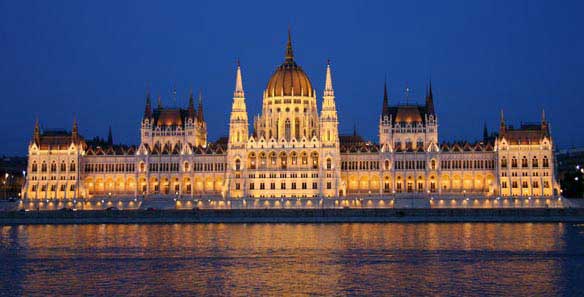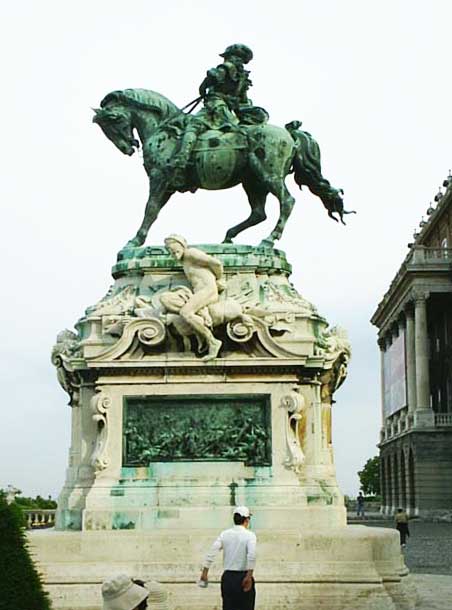We can never forget GE's "Hungarian Rhapsody" TV commercial from the early Nineties coinciding with the company's investment in Hungary and figurative lights coming back on across Eastern Europe as the Iron Curtain parted. Accompanied by Liszt's music of the same name, this thirty-second spot showcased the bridges of Budapest illuminated with Tungsram's light bulbs, cutting to elegantly attired couples whirling around a ballroom and a lady of a certain age pausing to say, "I feel young again." We were reminded of this touching paean to capitalism and freedom as we crossed the bridge over the Danube from Pest to Buda on our way to an unforgettable evening of duck, Tokay, and Liszt.

The opportunity to speak at a conference in Budapest had lured us first to Prague and then, after a leisurely seven-hour train ride, a few days in Budapest before heading back to my former home, Vienna. As children of the Cold War, we never imagined we would visit Prague or Budapest in our lifetimes, or that they would become thriving outposts of capitalism in a post-Communist world.

It didn't take long for us to succumb to romantic Budapest, 19th century co-capital and more wild and passionate counterweight to Vienna within the Habsburg Empire. Throbbing with folk melodies, exotic tonalities, and wild violin-playing gypsies, Hungary captivated composers such as the staid German, Johannes Brahms, as well as its own offspring from Franz Liszt to Zoltan Kodaly. When it comes to 19th century Gothic Revival architecture and monumental buildings, as well as equestrian statues of Prince Eugene of Savoy who saved both capitals from Turkish invasions in the 17th century, not even Vienna can top Budapest for sheer beauty and audacity.
Michael, always anxious to try local versions of duck dishes wherever we travel, had interrogated our taxi driver on the way from the train station for recommendations on the best duck in town. "Kacsa" was the emphatic reply, Hungarian for "duck." Attila, the masterful concierge at the Kempinski Hotel Corvinus, seconded this recommendation and booked our evening at the restaurant. Within an hour of arriving in Budapest we were crossing the Danube from Pest at twilight, bathed in the lights from the Chain Bridge, on our way to Kacsa in the heart of Buda.
We were welcomed by Roznai, the owner, into a smallish restaurant decked out in 19th century Habsburg style complete with a piano-violin duo of outstanding talent treating us to Liszt's and Brahms' Hungarian-themed music as well as to a Strauss waltz or two for good measure. The menu was a duck lover's delight and we took full advantage of it, reviewing the possibilities while enjoying the first of the evening's Tokays (Tokaji in Hungarian) — this one a drier, aperitif version of the Hungarians' more famous dessert Tokay (Aszú) so beloved that it is mentioned in the country's national anthem.
May being the height of asparagus season, Michael started with a cream of asparagus soup while I tried a traditional Hungarian fish soup. Michael opted for Roznai's own creation as his main course — duck with goose liver, apples, walnuts, onions, red cabbage and potatoes — a rhapsodic blending of diverse flavors in a memorable dish. I had the offering identified as the favorite of Roznai's wife — duck breast in paprika sauce. The duck was tender and cooked to perfection, the sauce a subtle and lightly perfumed introduction into the complex world of Hungarian paprikas.
To accompany our meal, we chose a Hungarian red wine, a Merlot that was a good match for the duck but otherwise unremarkable. For dessert, Michael chose the chocolate cake with chocolate sauce while I opted for the traditional Hungarian Palatschinken — delicate pancakes folded around crushed walnuts and covered in chocolate sauce. While a favorite in Vienna, nothing could compare with sampling this trademark dish in its hometown. To accompany dessert, we had a Tokay with 5 Puttonyes in the Hungarian ranking system denoting sugar in Tokays. Sweet without being cloying, it was the perfect foil for the pleasingly bitter chocolate sauce.
The musicians kept playing until we had sipped the last of our Tokay and were heading reluctantly for the door. Their tunes lingered in our heads as we rode back across the Danube to our hotel, filled to brimming with the memorable combination of duck, Tokay and Liszt.
Kacsa, Föutca 75, Budapest 1027, Buda, District 1
Next time, a legendary Doge of Genoa serves up dinner in Florence.
The original version of this article appeared in the Summer, 2010 edition of the Quarterly Newsletter of the Wine Society of Texas, a non-profit organization dedicated to wine education and appreciation.